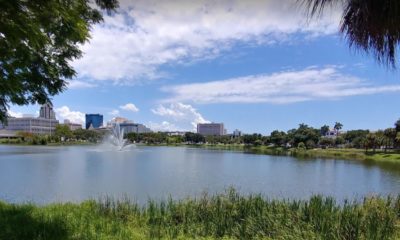Insight
Community Voices: The City’s Historic Preservation ordinance is working just fine

Welcome to the Catalyst’s Community Voices platform. We’ve curated community leaders and thinkers from all parts of our great city to speak on issues that affect us all. Visit our Community Voices page for more details.
In any successful city there is a necessary tension between development and historic preservation. This is not cause for concern. It’s a natural byproduct of a city in popular demand.
Yet, every few years, typically after a particularly heated public debate over possible designation of a historic landmark, there are cries to “do away” with third party applications. Every time, cooler heads prevail and City Council sees the wisdom in the historic preservation ordinance as it has been thoughtfully crafted over the years. That is where we find ourselves today, as City Council is poised to review the process for submission of historic landmark applications in a workshop scheduled for August.
Third party applications are so called to distinguish between the first party – the property owner, and the second party – the City of St. Petersburg, who should have a vested interest in submitting applications for local historic landmark status. Third party applications used to be called “citizen-initiated” applications, a more appropriate and less loaded description of applications generated by citizens hoping to protect a significant historical, architectural, cultural or aesthetic building in the city.
The city’s historic preservation ordinance (read it here) provides a mechanism to pause and evaluate what parts of the city are important to our identity during periods of rapid development. It is a planning tool that helps guide the development of the city in a way that remains mindful of our history, architecture and aesthetics – those very things that create the sense of place that makes the city so desirable. The City of St. Petersburg’s Historic Preservation Ordinance begins:
The City Council declares as a matter of public policy that the preservation, protection, perpetuation and use of local landmarks is a public necessity because they have a special historic, architectural, archaeological, aesthetic or cultural interest and value and thus serve as visible and tangible reminders of the history and heritage of this City, the state and nation. The Council finds that this section benefits the City’s residents and property owners and declares as a matter of public policy that this section is required in the interest of the health, prosperity, safety, welfare and economic well-being of the people.
The Numbers

Mercy Hospital nurses.
Through the tools established by the ordinance the city has recognized 110 local historic landmarks, including iconic buildings like the Snell Arcade, the Open Air Post Office and the Vinoy Hotel, and beloved institutions like Sunken Gardens and the Shuffleboard Courts. These places are offered a measure of protection through the Certificate of Appropriateness (COA) process, whereby demolition and/or significant exterior changes are reviewed by a City Council-appointed commission (the Community Planning and Preservation Committee, or CPPC) using criteria set forth in the historic preservation ordinance. Local landmark designation doesn’t mean the Snell Arcade can never be torn down, but you’d have to convince a diverse committee of experts in the fields of architecture, construction, history and real estate that there was a very good reason to do so.
There are more than 85,000 properties in the city of St. Petersburg. Only 110 of them bear some level of demolition review procedures through the local historic landmark designation. That’s 1/10th of one percent.
Of those 110 buildings, only nine of them were designated under applications submitted by a third party, over owner-objection (that’s .01 percent, for those that are counting.) Those include the Glen Oaks Cemetery, one of the two oldest cemeteries in St. Petersburg and burial site of the city’s first African-American settlers, John Donaldson and Anna Germain; Mercy Hospital – the designated hospital for African Americans in St. Petersburg from 1923-1966 and the oldest surviving hospital building in the city; Sunken Gardens – St. Petersburg’s most notable roadside tourist attraction (and site of countless weddings today); and the Detroit Hotel, built by city co-founder Peter Demens upon the city’s founding in 1888, and viewed by many as the city’s most historically significant building.
Sometimes property owners come to see the benefits of landmark designation and support a third-party application that they had originally opposed. An additional six properties have been designated under such circumstances, including: Jennie Hall Pool (the designated swimming pool for African Americans, built in 1954), the Shuffleboard Club and the stunning Acheson Home of Allendale.

The Soreno Hotel demolition.
Seven third-party applications for local historic landmark designation have been denied, two of which were subsequently demolished (The Soreno Hotel in 1994 and the Pheil Hotel, demolished in 2015) with another two demolitions likely soon (the Doc Webb home in Allendale and the Holiday Motel on 4th Street N.) One of the denied applications, North Ward School, was sold to a new owner who recognized the value of its historic character and renovated and reused the historic school building.
What is often lost in discussions of third party, or citizen-initiated, landmark applications are the successful compromises that have resulted between property owner and third party applicant. The Crislip Arcade, the nexus of the incredible renaissance of the 600 Block of Central Avenue, was saved through discussions generated by a third-party landmark application. The application to landmark Crescent Height’s American Church of the Beatitudes generated discussions between the developer who purchased the property and the neighborhood association concerned with losing a landmark. The discussions resulted in the developer agreeing to renovate the historic church building as a residence, a project about to get underway.
These statistics (you can review those mentioned and more, in a City memo, here) show the system is not broken, and establish how critically important the ability for citizens to submit an application for local historic landmark designation is to keeping St. Petersburg special, and to the city’s stated goal of preserving significant buildings from our history.
Owner-Consent Clauses
Said another way, to “do away” with third party applications would be to implement owner-consent clauses in our historic preservation ordinance – effectively giving an owner a veto in whether or not the property they currently own is worthy of historic landmark designation. There is a strong argument, which was recognized when the preservation ordinance was first adopted, that mandating owner consent that can be arbitrarily exercised as a prerequisite to designation could create legal issues.
The preservation ordinance is akin to a zoning ordinance. Property owner consent statutes in zoning law have uniformly been held unconstitutional wherein such consent is left to the whim of the owner. The U.S. Supreme Court has found on more than one occasion that an ordinance providing for owner consent before a zoning action occurs, and absent any standards for the owner to follow, runs afoul the due process clause of the 14th Amendment.
When St. Petersburg’s Community Planning and Preservation Commission, and later City Council, evaluate a building for eligibility as a local historic landmark they are making their determination based on a set of guidelines created by experts and voted on by City Council. Don’t let anybody fool you that designating a building historic is an easy process – it’s lengthy, research-intensive and bears a high standard of eligibility.
However, when a property owner weighs in on a building’s eligibility, they are making their decision based on personal subjective concerns, not the standards set forth by the city. As the Supreme Court found in the Seattle Title Trust case, property owners in this instance “are not bound by any official duty, but are free to withhold consent for selfish reasons or arbitrarily. The delegation of power so attempted is repugnant to the due process clause of the 14th Amendment.”
That’s a lot of legalese, but put simply: For better or worse, we don’t get to decide which laws apply to us and which don’t.
For a detailed discussion of this subject, read: Owner Consent Provisions in Historic Preservation Ordinances: Are They Legal?
Solutions
There are better solutions to the tension created by citizen-initiated applications. First, the City needs to hold up its end of the bargain. The City’s Comprehensive Plan sets forth a well thought-out framework for preservation activities with objectives and policies addressing how to identify the City’s important resources, how to protect those resources, and how to bring the various interest groups together to seek solutions to conflicts over preservation issues. The plan, among other things, calls for the city to nominate three properties a year to the list of local historic landmarks, while also holding an annual workshop on historic preservation. Unfortunately, the city hasn’t fully implemented these policies (specifically – the nomination of three landmarks a year), leading to some of the frustrations with the preservation program. When the only avenue for protecting historic resources falls to the citizens who care about their city, the potential arises for those citizens to be accused of greed, NIMBYism, reactionism or some other selfish interest.
Secondly, the city could increase incentives for preservation and better promote those incentives that currently exist.
Hold the Course
Are we to believe that less than 1% of the buildings in St. Petersburg are worthy of preservation? Asked another way, if we were to demolish 99% of the buildings in St. Petersburg and build new ones, would we be the same place? Would people still clamor to come here?
Tension between interested parties is one reason that pause buttons and release valves are necessary and welcome functions in the machinery of a city. That is partly the role of the historic preservation ordinance and the local historic landmark application process. It asks us to breathe deep, keep calm and carry on. Let’s do that now.








Mike Connelly
August 2, 2019at10:29 pm
Don’t Ft Lauderdale St. Petersburg
Stephen Jones
August 2, 2019at9:50 pm
I think the writer did a persuasive job of defending the preservation ordinance and landmark application process. The system always seems broken when it isn’t working in your favor or quickly enough. The final paragraph sums up why I will be assuming a more open mind in regards to these policies:
“Tension between interested parties is one reason that pause buttons and release valves are necessary and welcome functions in the machinery of a city. That is partly the role of the historic preservation ordinance and the local historic landmark application process. It asks us to breathe deep, keep calm and carry on. “